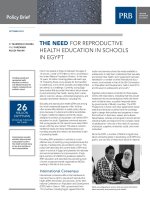Lung lavage for meconium aspiration syndrome in newborn infants
Bạn đang xem bản rút gọn của tài liệu. Xem và tải ngay bản đầy đủ của tài liệu tại đây (2.28 MB, 29 trang )
BS Nguyễn Phạm Minh Trí
Khoa Hồi Sức Sơ Sinh
Description of the condition
newborn inhales mixture of meconium and
amniotic fluid into lungs in delivery
Meconium Aspiration: The Statistics
Infants with MEC aspiration syndrome
35%
need mechanical ventilation
(range 25-60%)
12% die (range 5-37%)
Management: at present
Assisted ventilation
Sedation
Surfactant
Nitric oxide
ECMO
Circulatory support
Antibiotics
……
Largely SUPPORTIVE
Remove MEC from the lung:
Why NOT ???
Lung lavage for meconium aspiration
syndrome in newborn infants
(Review)
Hahn S, Choi HJ, Soll R, Dargaville PA
Cochrane Database of Systematic Reviews 2013
Issue 4. Art. No.: CD003486
Objectives
Evaluate Effects of LUNG LAVAGE on
Morbidity and Mortality in newborn infants
with MAS
Search methods
Search database:
Cochrane Central Register of Controlled Trials
(CENTRAL, The Cochrane Library), MEDLINE, and
EMBASE
up to December 2012
previous reviews including cross-references, abstracts,
conference proceedings; and expert informants
Search words:
meconium aspiration, pulmonary surfactants,
bronchoalveolar lavage, lung lavage, pulmonary lavage
Selection criteria
Randomised controlled trials that evaluated
the effects of lung lavage in infants with
MAS
Lung lavage: intervention in which fluid is
instilled into the lung and then removed by
suctioning and/or postural drainage
Fluids that have been used for this purpose include
saline, full-strength and dilute surfactant, and
perfluorocarbon
Standard care: no lavage therapy, but include
routine suction of the endotracheal tube to
maintain its patency
Results of the search
Twelve studies were excluded:
Four randomised controlled trials were identified
Burke-Strickland 1973; Carson 1976; Rosegger 1987; Ogawa
1997; Su 1998; Lam 1999; Schlösser 2002; Kowalska 2002;
Chang 2003; Salvia-Roigés 2004; Dargaville 2007; Armenta
2011
(Ogawa 1997) was excluded as data on the non lavaged
control group were not reported and are not now obtainable
Three studies are included in this review
Wiswell 2002; Gadzinowski 2008; Dargaville 2011
Study analysis
Type of lavage fluid
•
Lavage aliquot volume
•
•
All included studies used diluted surfactant for lavage
5 mL/kg in all studies comparing surfactant lavage
with standard care
5 mL/kg in the study comparing surfactant lavage
followed by bolus surfactant with surfactant bolus
therapy
Timing of lavage
•
mean age than six hours in all included studies
Comparison 1
LUNG LAVAGE VERSUS
STANDARD CARE
Lung lavage vs. Standard care
Two studies: Dargaville 2011; Wiswell 2002
Outcomes:
Death
Use of ECMO
Death or Use of ECMO
Pneumothorax
Indices of pulmonary function: Oxygenation Index,
AaDO2 and PaO2/FiO2
Outcome 1: Death
Outcome 2: Use of ECMO
Outcome 3: Death or use of ECMO
Outcome 4: Pneumothorax
Outcome 5: Oxygenation index
Outcome 6: AaDO2
Outcome 7: PaO2/FiO2
Result Analysis
Lung lavage has effect in all outcomes, but
only these are significant in statistics:
Outcome 3: Death or Use of ECMO
Outcome 5: Oxygenation index at 48 hours
Comparison 2
LUNG LAVAGE FOLLOWED BY
SURFACTANT BOLUS VERSUS
SURFACTANT BOLUS
Lung lavage followed by surfactant
bolus vs. surfactant bolus
One study: Gadzinowski 2008
Outcomes:
Death
Pneumothorax
Outcome 1: Death









